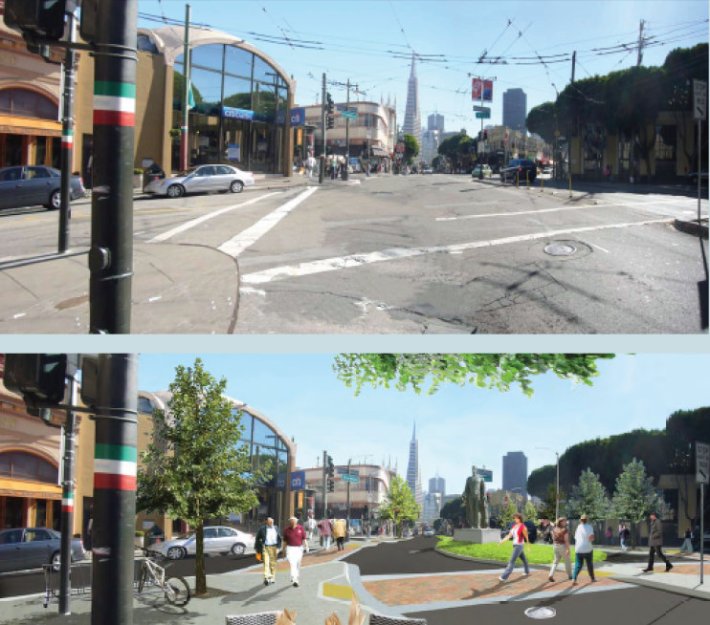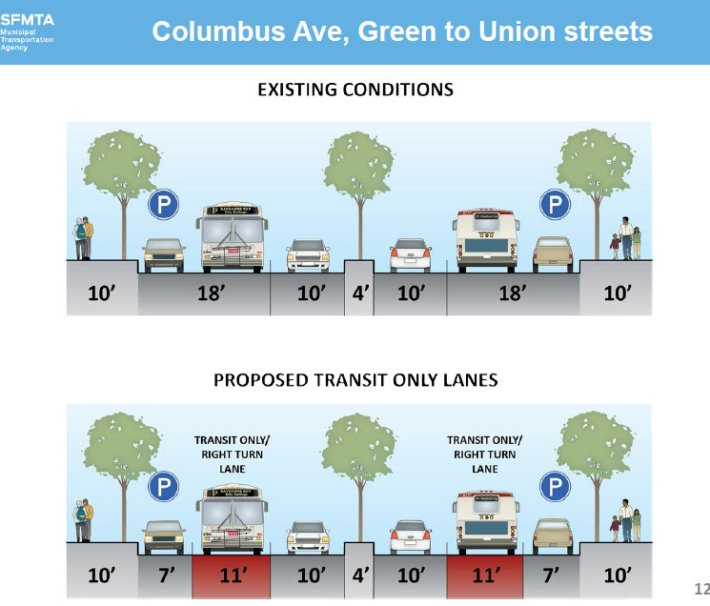
Over two-thirds of the space on Columbus Avenue is devoted primarily to cars, yet only one-third of the people on the street are typically in automobiles.
That’s according to a 2010 study of how to improve the design of Columbus, in which residents and transportation planners came to the conclusion that North Beach’s thoroughfare needs calmer traffic and more space for pedestrians, transit, and bicycling. Now, three years later, as the SFMTA looks to finally implement the ideas laid out in the plan, some merchants and residents are pushing back, dismissing the extensive analysis and community planning already done.
Columbus is set to be re-paved next summer, presenting an opportunity to cost-effectively implement the concepts in the SF County Transportation Authority study, which include bulb-outs on Columbus’ narrow, crowded sidewalks and an on-street plaza -- dubbed “Piazza St. Francis, the Poet’s Plaza” -- on an adjacent block of Vallejo Street. At the intersection of Columbus, Green, and Stockton Streets, traffic islands would be added to simplify motor vehicle movements, diverting traffic off westbound Green and southbound Stockton (converting it to a one-way street north of Columbus).
With a road diet, one stretch of Columbus, between Green and Union Streets, would get transit-only lanes, while 8-foot-wide buffered bike lanes would be installed between Green and Washington Streets (although the bike lanes weren’t included in the SFCTA study, the traffic impacts of a road diet were).
“Columbus is being re-paved, and probably won’t be re-paved for another 20 years,” SFMTA planner James Shahamiri said at a meeting with the Telegraph Hill Dwellers in October. “We have some funding, and we want to see what level of improvements we can make based on the community plan that was adopted by the TA.”
The "primary liaison between the [SFCTA] and the many stakeholders" involved in the development of the study, as described in the study itself, was Renew SF -- Revitalize and Energize the Northeast and Waterfront of San Francisco. Wells Whitney, the organization's founder, said neighborhood support for the plan still seems strong. “Almost everyone I’ve talked to is enthusiastic about wider sidewalks, more bulb-outs, bike lanes, and calming the traffic and making it more of a neighborhood boulevard than a thruway,” he said.
Leading the opposition to the safer street design is Daniel Macchiarini of the North Beach Business Association. Macchiarini told Streetsblog he doesn’t believe a road diet on Columbus will result in the kind of boost in livability and business that came with a similar, widely-lauded project on Valencia Street because, unlike Valencia, Columbus lacks alternative parallel routes for drivers. “This is another project that will stall traffic on Columbus Avenue,” he said.


“I think there’s an agenda in this city against the private car, and I’m not necessarily against the private car, to tell you the truth,” said Macchiarini. “I come from working class businesses in the city, and we’re being pushed, and shoved, and beaten more and more, and part of that is taking away private transportation.”
But while people walking, biking, and riding Muni on Columbus are squeezed for space, traffic lanes and parking garages go underused, according to the SFCTA’s study, buttressing the case that re-purposing them won’t result in the “chaotic and dangerous situation” that Macchiarini predicts. The SFMTA has implemented dozens of road diets in the city, which typically make streets more attractive to be on, while predictions of carmaggeddon never come to pass.
No other commercial street may be a better candidate for a road diet than Columbus, where car traffic dropped heavily after the fall of the Embarcadero Freeway in 1989, and 86 percent of people arrive without a car, according to the SFCTA study.
“It is not the thruway that it used to be,” said Whitney.
While Macchiarini and some residents have voiced fears that reducing four traffic lanes to two would cause car traffic to spill over on to other streets, Mike Sonn, chair of the Telegraph Hill Dwellers Transportation and Parking Committee, said he "fully supports a road diet on Columbus, [because] even at peak hours the traffic barely justifies four lanes.”
Putting aside the dangers created by prioritizing space for rush-hour drivers ahead of livability and other modes of transport, the traffic numbers support Sonn’s claim. According to a report from the Federal Highway Administration, road diets that reduce traffic lanes from four to two only result in spillovers on streets that carry more than 20,000 cars per day.
During rush hours, Columbus carries about 800 to 1,000 cars per hour, according to the SFCTA study. Though a daily traffic count wasn’t provided in the study, with those peak hour numbers, it seems unlikely that it would approach 20,000. Meanwhile, bicycling, walking, and Muni would become more attractive options with the improvements.
The extra capacity leads drivers to speed, said Sonn, creating “a dangerous and non-inviting atmosphere in the heart of North Beach.”
Some of the resistance to the SFMTA’s initiative may be related to the agency’s Central Subway project. Telegraph Hill Dwellers and a group of residents and merchants called "No North Beach Dig" are protesting the disruptions caused by subway construction in the neighborhood, which comes despite the lack of plans for a station there. Although backlash has already led the SFMTA to ditch its original plan to build a drill retrieval shaft on Columbus and close two of its traffic lanes for ten months -- moving the work instead to the site of the abandoned Pagoda Theatre -- opponents apparently will only be satisfied if the subway drill is left underground.
Macchiarini told SF Weekly in June of last year that "we will do whatever we can to stop this extraction plan."
When SFMTA staffers presented the proposal at the October THD meeting, it elicited some concerns about car traffic moving to other streets and, of course, complaints about the behavior of people on bikes.
The SF Bicycle Coalition has formed a committee to help galvanize support for “robust” improvements to make Columbus safer and more livable. “We've heard loud and clear from both our members in the neighborhood and other community groups that they want to see the ideas scoped in the 2010 SFCTA study incorporated into the city's upcoming repaving of the street,” said SFBC Deputy Director Kit Hodge. “This includes wider sidewalks, safe space for biking and continued strong support for all of the local businesses and the unique character of this incredible neighborhood.”
“It’s such an important part of the city for tourists and everybody who comes here,” said Eric Baldosser, a North Beach resident and member of the SFBC committee. Baldosser and Sonn both said wider sidewalks are the most pressing need along Columbus, where a few parklets installed by restaurant managers have been deemed a resounding success.
Other than bulb-outs, extensive sidewalk widening is not currently part of the SFMTA’s project, as staffers say they don’t have funding for it (it costs $1.5 million per block). However, the near-term improvements would set the stage for sidewalk widenings down the road, the real estate for which would come from on-street car parking, as recommended in the SFCTA study.
The near-term project would be financed by a mix of local funding sources, according to an SFMTA presentation:
- Pedestrian bulb-outs and island improvements at the Vallejo and Green/Stockton intersections would be funded by $800,000 in Prop B street re-paving bonds and $500,000 in SFMTA revenue bonds.
- Bus bulb-outs at Union Street and transit-only lanes would be funded by more than $300,000 in set-asides for the Muni Transit Effectiveness Project.
- Planning and implementation of bike lanes would require $150,000, the source for which has yet to be identified.
- The plaza at Vallejo would be designed and constructed using “private funds.”
It's a good time to revisit our Streetfilm from 2009 about poet and City Lights Books publisher Lawrence Ferlinghetti's vision for "The Poet's Plaza," which will finally become a reality.






